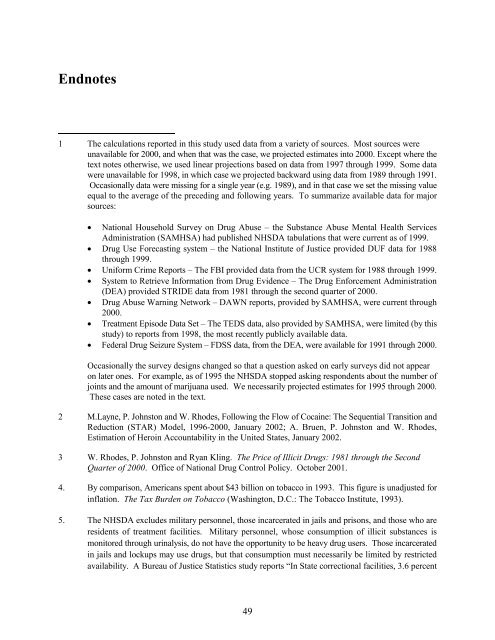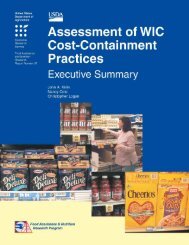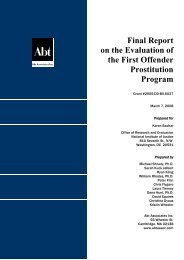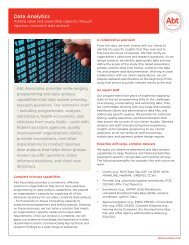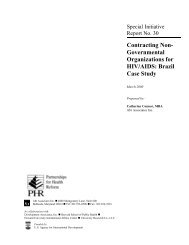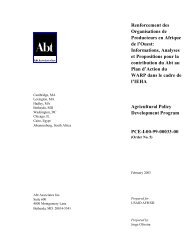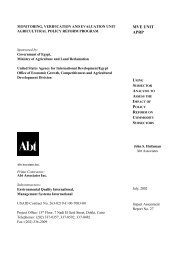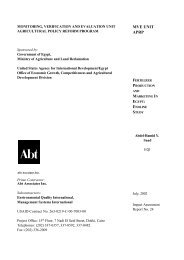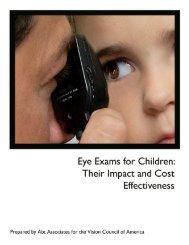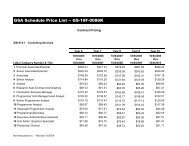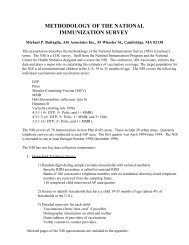What America's Users Spend on Illegal Drugs 1988-2000 - National ...
What America's Users Spend on Illegal Drugs 1988-2000 - National ...
What America's Users Spend on Illegal Drugs 1988-2000 - National ...
- No tags were found...
Create successful ePaper yourself
Turn your PDF publications into a flip-book with our unique Google optimized e-Paper software.
Endnotes1 The calculati<strong>on</strong>s reported in this study used data from a variety of sources. Most sources wereunavailable for <strong>2000</strong>, and when that was the case, we projected estimates into <strong>2000</strong>. Except where thetext notes otherwise, we used linear projecti<strong>on</strong>s based <strong>on</strong> data from 1997 through 1999. Some datawere unavailable for 1998, in which case we projected backward using data from 1989 through 1991.Occasi<strong>on</strong>ally data were missing for a single year (e.g. 1989), and in that case we set the missing valueequal to the average of the preceding and following years. To summarize available data for majorsources: Nati<strong>on</strong>al Household Survey <strong>on</strong> Drug Abuse – the Substance Abuse Mental Health ServicesAdministrati<strong>on</strong> (SAMHSA) had published NHSDA tabulati<strong>on</strong>s that were current as of 1999. Drug Use Forecasting system – the Nati<strong>on</strong>al Institute of Justice provided DUF data for <strong>1988</strong>through 1999. Uniform Crime Reports – The FBI provided data from the UCR system for <strong>1988</strong> through 1999. System to Retrieve Informati<strong>on</strong> from Drug Evidence – The Drug Enforcement Administrati<strong>on</strong>(DEA) provided STRIDE data from 1981 through the sec<strong>on</strong>d quarter of <strong>2000</strong>. Drug Abuse Warning Network – DAWN reports, provided by SAMHSA, were current through<strong>2000</strong>. Treatment Episode Data Set – The TEDS data, also provided by SAMHSA, were limited (by thisstudy) to reports from 1998, the most recently publicly available data. Federal Drug Seizure System – FDSS data, from the DEA, were available for 1991 through <strong>2000</strong>.Occasi<strong>on</strong>ally the survey designs changed so that a questi<strong>on</strong> asked <strong>on</strong> early surveys did not appear<strong>on</strong> later <strong>on</strong>es. For example, as of 1995 the NHSDA stopped asking resp<strong>on</strong>dents about the number ofjoints and the amount of marijuana used. We necessarily projected estimates for 1995 through <strong>2000</strong>.These cases are noted in the text.2 M.Layne, P. Johnst<strong>on</strong> and W. Rhodes, Following the Flow of Cocaine: The Sequential Transiti<strong>on</strong> andReducti<strong>on</strong> (STAR) Model, 1996-<strong>2000</strong>, January 2002; A. Bruen, P. Johnst<strong>on</strong> and W. Rhodes,Estimati<strong>on</strong> of Heroin Accountability in the United States, January 2002.3 W. Rhodes, P. Johnst<strong>on</strong> and Ryan Kling. The Price of Illicit <strong>Drugs</strong>: 1981 through the Sec<strong>on</strong>dQuarter of <strong>2000</strong>. Office of Nati<strong>on</strong>al Drug C<strong>on</strong>trol Policy. October 2001.4. By comparis<strong>on</strong>, Americans spent about $43 billi<strong>on</strong> <strong>on</strong> tobacco in 1993. This figure is unadjusted forinflati<strong>on</strong>. The Tax Burden <strong>on</strong> Tobacco (Washingt<strong>on</strong>, D.C.: The Tobacco Institute, 1993).5. The NHSDA excludes military pers<strong>on</strong>nel, those incarcerated in jails and pris<strong>on</strong>s, and those who areresidents of treatment facilities. Military pers<strong>on</strong>nel, whose c<strong>on</strong>sumpti<strong>on</strong> of illicit substances ism<strong>on</strong>itored through urinalysis, do not have the opportunity to be heavy drug users. Those incarceratedin jails and lockups may use drugs, but that c<strong>on</strong>sumpti<strong>on</strong> must necessarily be limited by restrictedavailability. A Bureau of Justice Statistics study reports “In State correcti<strong>on</strong>al facilities, 3.6 percent49


